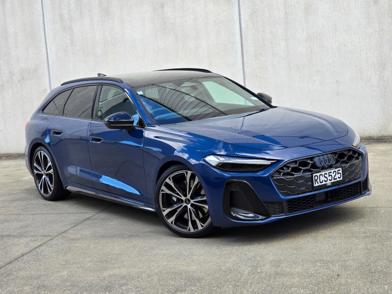To many, the M3 represents the essence of BMW M. It’s been an icon for the performance brand since 1986, loved by purists, and yet the company has never been fixated on it needing to be a particular thing. It’s had four, six and eight-cylinder engines, it’s been a sedan, coupe (albeit with an “M4” badge these days) and convertible.

What we’ve never had is an M3 station wagon. Which seems incredible when you consider how much success rivals Audi Sport and Mercedes-AMG have had with super-fast estate cars.
Perhaps even more incredible when you consider that it’s probably not that hard to do. There’s already an M3, there’s already a 3-Series Touring (that’s BMW-speak for wagon). Marry the two together, a bit of tweaking and you’re done. We might be over-simplifying, but you get the point.

For the record, M wagons are not a complete unknown. BMW has produced two M5 Touring models over the years and both have been pretty niche: an E34 model in 1992 and the E61 from 2004 (and yes, there’s another on the way next year). But no M3, save a “feasibility study” of the E46, constructed in 2000.
Until now. While BMW M remains vague as ever on the whys and wherefores, we now have an M3 Touring.

“I know it’s been a car that a lot of fans have been waiting for, for a long time,” says BMW M chief executive Frank van Meel. “It took us a while to do it because in the past we didn’t see a market opportunity big enough. But now that the M3 and M4 have grown so strong, there’s a place for an additional member.”
BMW M has kept it simple. The M3 Touring is only available globally in Competition xDrive form, which fits perfectly with the M3 sedan specification in New Zealand. That means 375kW/650Nm, a clever all-wheel drive system… and a cool name.

Ironically, an M3 Touring is a little harder to justify in these days of hugely accomplished high-performance SUVs. After all, if you’re willing to sacrifice weight (the Touring is 85kg heavier than the sedan) for extra practicality, an SUV like BMW’s own X3 M Competition offers superior comfort, rear-seat space and cargo capacity.
But there’s something delightfully perverse about a crazy-fast wagon and it certainly pushes the right buttons for hard-core car enthusiasts, who love the heritage of the M3 and will argue all day that a performance vehicle is always better when it’s lower to the ground. The M3 Touring is very low indeed.

And although it’s not a massively spacious wagon, it’s still decently practical: BMW’s signature 30/20/30-split rear seat, grippy finish on the boot floor, 500 litres volume and a nifty tailgate with separate glass opening. In all the excitement about the first-ever M3 Touring, it’s easy to forget BMW has been making 3-Series wagons forever.
BMW M boss van Meel argues the M3 Touring is doing a good job of attracting new buyers: “This one has surprised us a little bit. We were quite bold in what we expected from the market, but the requests are even more. People are not changing from M3 or M4; these are customers we didn’t have before.”

Oh, by the way: we’ve had a taster drive on road and track in Australia and the M3 Touring is absolutely sensational. Surprised? Thought not.
It’s still crazy-fast, just 0.1sec slower than the sedan (3.6sec) and every bit as exhilarating. Sure, there are electric cars that are faster (not many, though), but the M3 powertrain is still a real shot of ICE through your veins at speed.

It’s never just about straight-line speed, of course. The trick for BMW M was adjusting the chassis and bodyshell-strength of the Touring to match the handling and dynamic response of the sedan as as closely as possible. Finessing in other words, which is what M does best.
Any M3 requires some compromise as a daily driver: it’s low and the suspension is pretty firm, even in its most comfortable setting. It’s still a very serious performance car, albeit one that’s fast and fluent on real-world roads.

Our drive time wasn’t extensive – a quick hop from Adelaide to Tailem Bend, home of The Bend racetrack. Which did also mean a few laps of the circuit in the Touring, where it proved as capable and entertaining as many other M3 or M4. Track credentials are still key to the M brand.
A professional racing driver would no doubt be aware of the nuances that make the heavier Touring a slightly less capable track car than the sedan or M4 coupe, but for everybody else it’s simply an epic experience that wears its blue-and-red badge with pride.

By the way: “Racing drivers love this car,” says van Meel. “Because they can take their bikes along for the trip as well.”
At $195,600, the Touring is just $4400 more than the sedan. So it’s not really a matter of having to justify its existence, because it’s there as a choice.

The spec is equivalent to the four-door, which means its fully loaded with digital this and live that. There are still a few options, including M Carbon Ceramic Brakes ($16,500) if you’re absolutely set on regular track days and the M Carbon Bucket Seats, which look amazing but make the car harder to get in and out of, and have a very hard bit in a very awkward place at the front. Enough said.
Which is our way of saying the M3 Touring is impossibly desirable and cool just the way it is.
BMW M3 COMPETITION TOURING
ENGINE: 3.0-litre turbo-petrol inline six
POWER: 375kW/650Nm
GEARBOX: 8-speed automatic, AWD
0-100KM/H: 3.6sec
CONSUMPTION: 10.4l/100km, CO2 235g/km
PRICE: $195,600

















